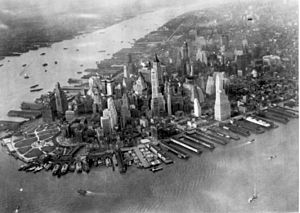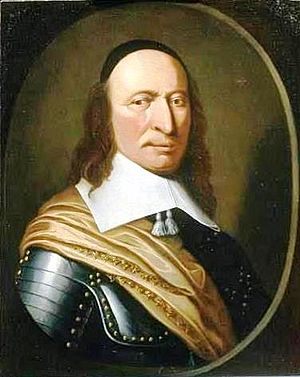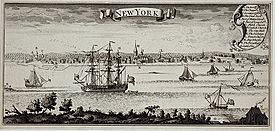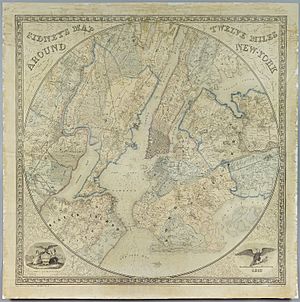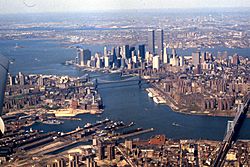Lower Manhattan facts for kids
Quick facts for kids
Lower Manhattan
Downtown Manhattan, Downtown New York City
|
|
|---|---|
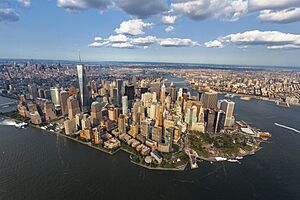
Lower Manhattan, including Wall Street, anchoring New York City's role as the world's principal fintech and financial center, with One World Trade Center, the tallest skyscraper in the Western Hemisphere
|
|
| State | |
| City | New York City |
| Borough | Manhattan |
| Settled | 1626 |
| Population
(2010)
|
|
| • Total | 382,654 |
| ZIP Codes |
10004, 10005, 10006, 10007, 10038, 10280, 10012, 10013, 10014
|
| Area code(s) | 212, 332, 646, and 917 |
| Median household income | 1,953 |
Lower Manhattan, also known as Downtown Manhattan, is the southernmost part of Manhattan. Manhattan is the main borough of New York City. This area is where New York City first began. For its first 225 years, Lower Manhattan was the entire city. It is also where the government of Manhattan and New York City is located. Many people have moved to Lower Manhattan, making it one of the fastest-growing areas in New York City.
Lower Manhattan is known for Wall Street and the Financial District. New York City is a major global center for money and technology. The Financial District has the New York Stock Exchange and other big financial groups. Lower Manhattan is also a hub for culture and tourism. It has many famous buildings like New York City Hall, the Woolworth Building, the Stonewall Inn, the Bull of Wall Street, and One World Trade Center. One World Trade Center is the tallest skyscraper in the Western Hemisphere.
Contents
Exploring Lower Manhattan's Geography
Lower Manhattan is bordered by 14th Street to the north. The Hudson River is to the west, and the East River is to the east. To the south is New York Harbor. The main business area is south of Chambers Street. This includes the Financial District, often called Wall Street. It also includes the World Trade Center site.
At the very southern tip of the island is Battery Park. City Hall is located north of the Financial District. South of Chambers Street, you'll find Battery Park City and South Street Seaport. TriBeCa is on the west side of Chambers Street. The large Manhattan Municipal Building is at the east end of Chambers Street.
North of Chambers Street and the Brooklyn Bridge, but south of Canal Street, is Chinatown. This area has the largest group of Chinese people in the Western Hemisphere. Many court buildings and government offices are also here.
North of Canal Street and south of 14th Street are neighborhoods like SoHo, the Meatpacking District, the West Village, Greenwich Village, Little Italy, Nolita, and the East Village. Between 14th and 23rd Streets, you can find lower Chelsea, Union Square, the Flatiron District, Gramercy, and Stuyvesant Town–Peter Cooper Village.
A Look at Lower Manhattan's Past
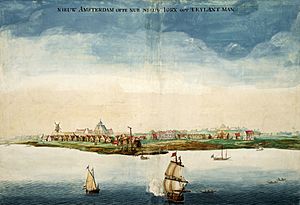
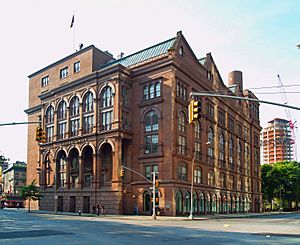
Early Days: Lenape People and Dutch Settlers
The land that is now New York City was first home to the Lenape people. These Native American groups spoke a language called Unami.
European settlement began when the Dutch set up a fur trading post in Lower Manhattan. This settlement was later called New Amsterdam in 1626. The first fort was built at the Battery to protect the area.
Around 1626, work began on Fort Amsterdam. The Dutch West Indies Company brought in African people to work as laborers. They helped build a wall to protect the town from attacks. Important leaders included Willem Verhulst and Peter Minuit. Willem Kieft became the director in 1638. He was involved in a conflict with Native Americans called Kieft's War. A sad event called the Pavonia Massacre happened in 1643. After this, Native American tribes joined together. The Dutch sent more soldiers, which led to a peace treaty in 1645.
On May 27, 1647, Peter Stuyvesant became the new director general. The colony was allowed to govern itself in 1652. New Amsterdam officially became a city on February 2, 1653.
From Dutch to English: The 17th and 18th Centuries
In 1664, the English took control of the area. They renamed it "New York" after the Duke of York. At this time, about 20% of the city's people were of African descent. The Dutch briefly got the city back in 1673, calling it "New Orange." But they gave it back to the English for good in 1674.
As the colony grew, people wanted more freedom. In 1689, Jacob Leisler led a revolt called Leisler's Rebellion. He controlled the city for a short time before being arrested.
By 1700, the Lenape population in New York had dropped to 200. By 1703, many households in New York had enslaved people.
In 1735, a trial involving John Peter Zenger helped establish freedom of the press in North America. This idea later influenced the United States Declaration of Independence.
By the 1740s, enslaved people made up 20% of New York's population. After some fires in 1741, people worried about a conspiracy. Officials arrested and punished many people, though historians believe the fears were mostly untrue.
In 1754, Columbia University was founded in Lower Manhattan. It was first called King's College.
The Stamp Act and other British rules caused anger. The Sons of Liberty protested. The Stamp Act Congress met in New York City in 1765. This was the first organized protest against British rule in the colonies. After a major defeat in the Battle of Long Island, General George Washington's army left Manhattan. The British then controlled the city for the rest of the American Revolutionary War. New York City became a safe place for people loyal to Britain. It was also a key spot for Washington's spies.
New York City was badly damaged by fires during British rule. The British held many American prisoners on prison ships in Wallabout Bay, across the East River. More Americans died on these ships than in all the battles of the war. British rule ended on November 25, 1783. George Washington returned to the city that day.
From 1785, the Congress met in New York City. In 1789, New York City became the first national capital of the United States under the new U.S. Constitution. The first Congress met at Federal Hall on Wall Street. The United States Bill of Rights was written and approved there. George Washington became the first U.S. President at Federal Hall. New York City was the capital until 1790.
Growth and Change: The 19th Century
New York grew as a center for business. This was partly due to Alexander Hamilton's work as the first Secretary of the Treasury. The opening of the Erie Canal in 1825 also helped. It connected the Atlantic port to farms in North America. Immigration increased. A new street grid system, the Commissioners' Plan of 1811, covered all of Manhattan. In the early 1800s, landfill was used to expand Lower Manhattan.
In 1898, the modern City of New York was formed. This happened when Brooklyn (which was a separate city) and other areas joined Manhattan. The Brooklyn Bridge connected Brooklyn to Lower Manhattan.
Modern Times: The 20th and 21st Centuries
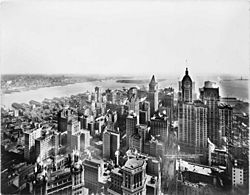
The Washington Market was a busy area for trade. Throughout the early 1900s, many tall buildings were built. These included 40 Wall Street, the American International Building, and the Woolworth Building.
On March 25, 1911, the Triangle Shirtwaist Factory fire in Greenwich Village killed 146 workers. This led to big improvements in fire safety and workplace rules.
In the first half of the 20th century, New York became a world center for business and communication. The first New York City Subway line started in 1904. The city's government and buildings were greatly improved under leaders like Fiorello La Guardia.
In the 1950s, Lower Manhattan faced economic challenges. David Rockefeller led efforts to rebuild the area. He helped plan the World Trade Center. It was built on land created by filling in the river. This new land, called Battery Park City, brought many new residents.
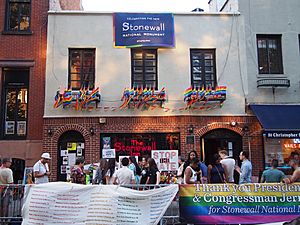
In 1969, the Stonewall riots happened at the Stonewall Inn in Greenwich Village. These protests by the gay community against a police raid are seen as a key event. They helped start the modern fight for LGBT rights in the United States.
Since the early 1900s, Lower Manhattan has been important for arts and entertainment. Greenwich Village was a center for bohemian culture. Many jazz clubs are still there. It was also a main place for the American folk music revival in the 1960s. Many art galleries were in SoHo. Today, the art scene is in Chelsea. Lower Manhattan has also been home to many alternative theater groups. Punk rock music started in the 1970s at places like CBGB and Max's Kansas City.
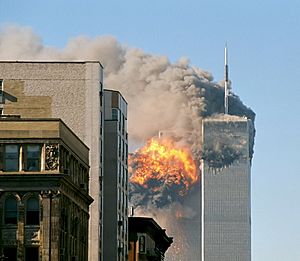
On September 11, 2001, two hijacked planes hit the Twin Towers of the World Trade Center. The towers collapsed, causing many deaths and damage. Lower Manhattan lost much of its economy. But most of the area has been rebuilt. The National September 11 Memorial opened in 2011. The new One World Trade Center opened in 2014. It is the tallest skyscraper in the Western Hemisphere.
The Occupy Wall Street protests began in the Financial District in 2011. They drew worldwide attention to social and economic inequality.
In October 2012, Hurricane Sandy hit Lower Manhattan. It caused severe flooding and power outages. This led to talks about building seawalls to protect the city from future storms.
Lower Manhattan has seen a "baby boom," with more births than other parts of Manhattan. The population of the Financial District has almost doubled since 2000. In 2015, The New York Times said Lower Manhattan's dining scene was becoming popular again.
Famous Historical Places to See
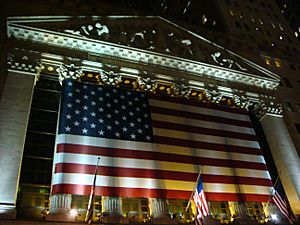

The World Trade Center site is a very famous landmark in Lower Manhattan. Before the September 11 attacks, the Twin Towers were symbols of the area's global importance. The new towers, including One World Trade Center, are helping Lower Manhattan become a major business district again. The 9/11 Memorial is a popular place for visitors.
The area has many historic buildings and sites. These include Castle Garden, Bowling Green, and the old Alexander Hamilton U.S. Custom House. This building is now the National Museum of the American Indian. You can also see Federal Hall, where George Washington became the first U.S. President. Other sites are Fraunces Tavern, New York City Hall, the Museum of American Finance, and the New York Stock Exchange. The renovated buildings of the South Street Seaport are also here. Don't forget the Brooklyn Bridge and South Ferry. From South Ferry, you can take ferries to Staten Island, Liberty Island, and Ellis Island. Trinity Church is another important site.
Lower Manhattan also has some of New York City's most amazing skyscrapers. These include the Woolworth Building, 40 Wall Street, the Standard Oil Building, and the American International Building.
What "Downtown" Means
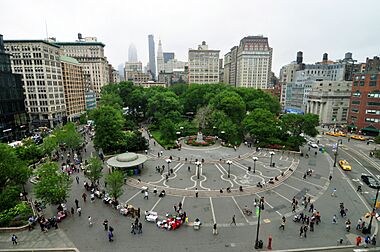
The word "Downtown" can mean different things to different people in New York City. If you live in Manhattan or The Bronx, "going downtown" often means traveling south to any part of Manhattan. If someone says they will "be downtown," they might mean anywhere south of 14th Street. This is the definition used by the city's tourism group. Some people even include areas south of 23rd Street.
The full phrase Downtown Manhattan can also mean just the area south of Canal Street. In business, "Downtown Manhattan" often refers only to the Financial District and nearby offices. For example, the Alliance for Downtown New York defines "Downtown" as south of Murray Street. This includes the World Trade Center area and the Financial District. The phrase Lower Manhattan can apply to any of these definitions. It depends on whether you're talking about the whole city or just the business and historical parts.
In popular culture, "Downtown" in Manhattan has often meant a place to have fun. The song "Downtown" by Petula Clark talks about forgetting your worries there. Billy Joel's song "Uptown Girl" contrasts a "downtown man" with the "uptown" world.
Lower Manhattan's Economy

Lower Manhattan is the third-largest business district in the United States. It is smaller than Midtown Manhattan and the Chicago Loop. With Wall Street at its core, New York City is the world's capital for finance and financial technology. It is called the world's most economically powerful city.
Lower Manhattan is home to the New York Stock Exchange at 11 Wall Street. It also has the main office of NASDAQ at 165 Broadway. These are the world's largest and second-largest stock exchanges.
Many large companies have their main offices in Lower Manhattan. Some of these include:
- AIG, at 175 Water Street
- Ambac Financial Group
- AOL, at 770 Broadway
- BARKER, 30 Broad Street
- Condé Nast, One World Trade Center. They publish magazines like Vogue and The New Yorker.
- EmblemHealth and Standard & Poor's, at 55 Water Street
- Goldman Sachs, at 200 West Street
- Group M, 3 World Trade Center
- Hudson's Bay Company, Brookfield Place. They own stores like Saks.
- IBT Media, which publishes the International Business Times and Newsweek.
- Nielsen Company and Nielsen Media Research
- PR Newswire, at 350 Hudson Street
- Spotify, 4 World Trade Center
- Verizon Communications, at 140 West Street
See also
 In Spanish: Bajo Manhattan para niños
In Spanish: Bajo Manhattan para niños


